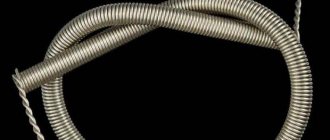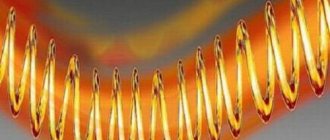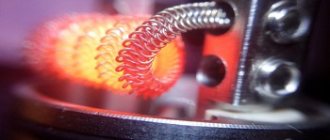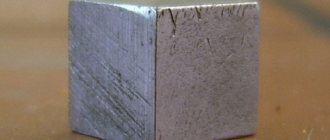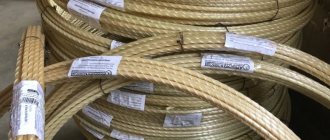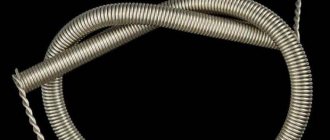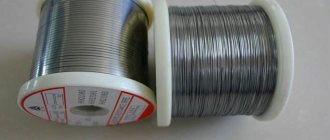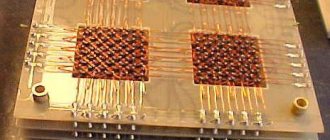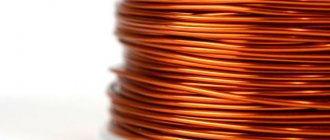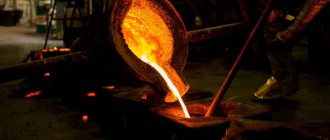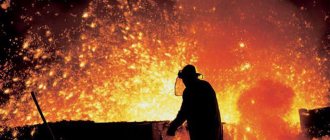Compound
Nichrome contains about 20% nickel and up to 80% chromium.
In addition, the alloy may contain additives in the form of manganese, aluminum, iron, silicon, etc.
The introduction of alloys into the nichrome composition increases the performance indicators and technical parameters of the metal:
- nickel and iron improve machinability;
- iron, titanium, aluminum and manganese reduce resistance to elevated temperatures;
- In the presence of iron in the alloy, nichrome acquires magnetic properties.
Increasing additives can degrade the characteristics of the metal.
The amount of nickel determines the temperature that the heating elements can withstand.
The chromium content in the alloy should be no more than 20%. An increase in the amount of chromium increases the brittleness and impairs the machinability of the metal. When its content in the alloy is more than 30%, cold rolling and drawing of the material becomes impossible.
The strength of the protective film and oxidation resistance depend on the amount of chromium.
Properties of nichrome
The alloy is characterized by good ductility and high electrical resistance. Its value can range from 1100 to 1400 Ohm mm²/m, depending on the type of metal.
Table 1. Technical characteristics of nichrome.
| Options | Indicators |
| Strength | 650-700 MPa |
| Melting temperature | 1100-1400°С |
| Working temperature | 800-1100°С |
| Density | Up to 8200-8500 kg/m3 |
| Resistance | 650-700 MPa |
| Coefficient of thermal conductivity | 11.3 W/(m K) |
| Linear thermal resistance coefficient | 14·10¯⁶Kˉ¹ |
| Ultimate tensile strength | 0.65-0.70 GPa |
Products made from nichrome are easily deformed while maintaining the given shape.
Nichrome does not have magnetic properties, with the exception of an alloy that contains an iron alloy.
Figure 2. Heating element.
Characteristics of nichrome and its application
The alloy consists of 50−80% nickel and 15−24% chromium with a small amount of additives in the form of aluminum, manganese and chromium. Alloying with rare earth components is possible to increase service life.
Cr20Ni80 is the most common type of material, and wire made from this alloy is the most popular. In second place are stripe and ribbon, and the least popular is the leaf shape.
Depending on the grade of the alloy, it has the following physical characteristics:
- Melting point 1100 - 1400 °C, operating temperature 800−1100 °C.
- Specific resistance depending on the alloy = 1.05−1.4 Ohmxmm²/meter.
- Thermal conductivity coefficient = 11.3W/(mxK)
Nichrome has a number of advantages over wires made of other alloys:
- No corrosion. Nichrome does not rust, unlike Kanthal alloy, which allows you to use it much longer.
- Nichrome thread has lower resistivity and thermal conductivity than kanthal. This allows you to get the required power using less wire, but sometimes this is a disadvantage.
- Does not change its physical properties when exposed to high temperatures.
- Nichrome is durable and hard. However, before burning it is springy, which can be a disadvantage in some situations.
- Good ductility, which allows for such types of mechanical processing as welding, sharpening, stamping.
- Has high heat resistance.
- The amount by which the resistance of nichrome changes with increasing temperature can be neglected
Nichrome is used in most devices, such as:
- Devices for cutting foam plastic.
- Glass heating systems.
- In muffle furnaces for melting metals.
- In hair dryers, irons, heaters.
- In vaporizers for electronic cigarettes.
- In devices for wood burning.
- Furnaces for drying and firing.
- In parts operating at high temperatures
As you can see, nichrome has good physical properties and is not subject to corrosion, which extends its service life compared to other types of similar materials used for the same purposes. The scope of its use in everyday life is also vast, so the question is often asked - where can you get nichrome thread. Most common options for obtaining nichrome will be listed below.
Nichrome brands
The most common brands in the industry include:
- X20N80 is a classic alloy containing about 20% chromium and 80% nickel;
- X15N60 - the alloy has reduced chromium and nickel content, increased iron content to 25%;
- Kh20N80-N (-N-VI) and Kh15N60 (-N-VI) - alloys produced in vacuum induction furnaces;
- N50K10, X25N20 - grades of nichrome used for work at temperatures up to 900°C.
Alloys produced in vacuum induction furnaces are distinguished by the fact that their electrical resistance changes little with temperature changes.
Explanation of brands:
- X – chromium (Cr);
- N – nickel (Ni);
The numbers indicate the percentage of the composition.
Additional letters mean:
- VI - vacuum induction melting;
- H - category of heating elements;
- C - use in resistance elements;
- Heating element - intended for dry type electric heaters.
For example, the brand X20N73YUM-VI indicates: chromium content - 20%, nickel - 73%, aluminum - 3%, molybdenum - 1.5%, manganese - up to 0.3%, titanium - up to 0.05%, iron - 2 %, carbon - up to 0.05%. The alloy was smelted using the vacuum induction method.
The purpose and properties of nichrome products are determined by the chemical composition of the alloy.
International designations
In the international names of nichrome you can find the following designations:
- Cronix 80;
- NiCr80/20;
- Nichrome V;
- Chromel A;
- HAI-NiCr 80;
- Ni80Cr20;
- Nikrothal 8;
- Resistohm 80;
- euronichrome.
European analogues of ferronichrome: NiCr60/15, Ni60Cr15, ChromelCN6, Nikrothal 6, Nikrothal 60, CroniferII, AlloyC.
Stamps
Nichrome is a heat-resistant alloy, has high electrical resistance, a low temperature coefficient of resistance, and significant corrosion resistance to air or other gaseous media at high temperatures. It also has satisfactory manufacturability (cold ductility, weldability) - nichrome wire, thread, tape, strip, rods and other semi-finished products can be obtained from this material; sufficient heat resistance - the ability to withstand mechanical loads without significant deformation, without collapsing at high temperatures. Oxides that are stable at high temperatures are formed on the surface of these alloys. The oxide film has a high density. These two factors ensure the high heat resistance of this precision material.
The most widely used brands are X20H80 and X15H60. Nichrome Х20Н80-Н, Х20Н80-VI, Х15Н60-Н, Х15Н60-VI are also used. The marking of these alloys is deciphered as follows: the letter denotes a chemical element, the number following it is the average mass fraction of this element in the alloy. For example, nichrome X20N80 contains 20-23% chromium (Cr) and about 80% nickel (Ni), X15N60 - 15-18% chromium (Cr) and about 60% nickel (Ni). The letters VI at the end of the brand indicate that this material was manufactured in a special way, namely, using vacuum induction melting. The letter H at the end of the brand indicates that the composition includes zirconium, which increases the reliability of the heater made of nichrome by increasing resistance at maximum operating temperature.
The chemical composition of grades Х20Н80, Х20Н80-Н, Х20Н80-VI and Х15Н60, Х15Н60-Н, Х15Н60-VI is regulated by the GOST standard 10994-74.
Advantages and disadvantages
Nichrome alloys are characterized by high electrical resistance.
The resistivity of nichrome is 10 times higher than that of galvanized steel and 70 times higher than that of copper.
Other advantages include:
- high mechanical strength and hardness;
- heat resistance and absence of temperature deformation;
- low specific gravity and good ductility;
- resistance to corrosion and aggressive environments;
The material is easy to process: sharpening, stamping, welding, etc. It does not change its characteristics when exposed to high temperatures.
Due to its resistance to corrosion and aggressive external environments, the alloy has an almost unlimited service life.
The disadvantages of the material include high cost.
Reducing the percentage of chromium in the alloy makes the product cheaper, but also reduces the technical properties of the material.
Distinctive characteristics
Among the most popular electrical products on the market is nichrome wire. This component of electric heating technology is extremely high, which allows it to have a wide demand.
An important feature of the metal is its resistance to high-temperature oxidation under normal and aggressive conditions. Chrome plays a key role here
The element forms a corresponding oxide film on the surface, which performs a protective function. It is also responsible for the corresponding dark color of the material, which is replaced by a characteristic white-gray when the oxidized layer is mechanically removed.
It is worth noting that direct contact with acids still destroys it, even more than corrosion-resistant tungsten.
The two-component alloy has no magnetic characteristics. They arise for its multicomponent modifications, but have weakened indicators.
Nichrome wire is rigid and does not lend itself to simple force.
We systematize information on how to identify nichrome wire, mainly how to distinguish it from externally similar materials:
- White is the color of new metal, dark is the color of previously worked metal.
- Negative or minimal magnetism.
- Rigidity.
- Destruction by acids, resistance to oxidation under the influence of high temperatures.
Making wire and tape from nichrome
Almost all electric stoves and electrical appliances use nichrome wire, thread or tape as heating elements.
There are several ways to make products from nichrome:
- Wire and thread drawing with intermediate heat treatment. Immediately before drawing, wire rod with a diameter of 6-8 mm is heated in special furnaces to a temperature of 1170-1230°C and quickly cooled. The heating temperature of the workpiece depends on the composition of the alloy. The next stage is pickling the wire rod in a mixture of hydrochloric and nitric acid with water.
Nichrome wire drawing is performed using high pressure. The production of products by drawing method is regulated by the requirements of GOST 8803-89
- Drawing of a hot-rolled billet to obtain a nichrome strip. This method allows the output to be a high-quality strip that exactly matches the profile and cross-section of the drawing channel. The resulting tape is of high quality and has no sharp edges.
- Cold drawn broach. The method is used for the production of wire and threads from nichrome. It is carried out without preheating the workpiece. Regulated by GOST 12766.1-90
- Cold rolling. Used for making nichrome tape. Performed in accordance with the requirements of GOST 12766.2-90.
- Flattening - used to produce strips from precision alloys with high electrical resistance. Performed in accordance with GOST 12766.5-90.
Nichrome tape.
The dimensions, mechanical properties and other parameters of nichrome wire are regulated by state standards or technical specifications.
Tungsten wire and its features
Basic properties of tungsten
Tungsten is a refractory metal that is used in the manufacture of heat-resistant alloys. It has a high density, its density reaches 19.3 g/cm3. Tungsten begins to melt at 3395°C and boils at 5500°C, while its evaporation rate is low. As for the electrical conductivity of this metal, it is approximately 1/3 of the value of the same parameter for copper. Tungsten is brittle at low temperatures and also has low oxidation resistance. This metal can be processed by pre-heating it. Externally, tungsten is similar to steel.
Tungsten wire production
The most popular long products made from tungsten are wire. It is produced in accordance with GOST 25501-82. Tungsten wire is a semi-finished product, the cross-section of which remains constant along its entire length. It is made by pressing or drawing.
Since tungsten has low technological plasticity, to increase this property it is heated, which in no way affects the strength of the material, which still remains high. Only after such procedures can wire be obtained by any method of processing under pressure. Supplied in coils or coils.
Powder metallurgy methods are often used to produce tungsten blanks, which makes it possible to improve some of the quality and properties of tungsten. A shtabik is a semi-finished product from which wire is made. It is first heated, and then a special rotary forging machine is used to carry out the forging. This is how tungsten rods are obtained, the diameter of which is 2-3 mm. Wire is obtained from them by drawing in a heated state. The diameter of the resulting long rolled metal is represented by a number of standard values up to 0.3 mm.
Scope of application of tungsten wire
The electrical and electronics industries are the main consumers of pure tungsten. The metal is indispensable in cases where low vapor pressure is required at operating temperatures up to 2500 °C. Tungsten wire is a material for heating elements of furnaces operating in a hydrogen, neutral or vacuum environment, heating up to 3000 °C. Thermocouples are made from this grade of metal. For their manufacture, tungsten-rhenium wire with a rhenium content of 5 and 20% (VR 5/20, VR5/20, VR5/VR20) is used.
More information about the use of tungsten wire grades VA, VM, VRN, VT-7, VT-10, VT-15 can be found by reading GOST 18903-73.
Areas of use
High corrosion resistance, the ability to work in aggressive conditions, and high-quality technical characteristics allow the material to be used in various fields.
In industrial installations and electrical equipment:
- high temperature electric furnaces;
- ventilation dryers;
- boilers and heat exchangers;
- welders;
- single-core and multi-core electrical wires;
- structural elements of metal-smelting equipment;
- powder paint polymerization chambers;
- devices for cutting foam;
- resistors, rheostats.
Heating elements made of nichrome are installed in car cigarette lighters, glass and seat heating systems in cars.
Special grades of complex alloyed nichrome with a low coefficient of electrical resistance are used as a heat-resistant coating when performing thermal spraying.
At home
The material is used in almost all modern household appliances:
- electric stoves and ovens;
- heaters and boilers;
- washing machines and toasters;
- hair dryers and irons;
- electric soldering irons and wood burning devices;
- electronic atomizers and light bulbs.
The use of spirals in household electric stoves.
Nichrome threads are widely used in medicine as a suture material during intracavitary surgical and plastic operations.
For each application, certain grades of alloys with optimal technical characteristics are produced.
Where is nichrome wire used?
Plasticity, resistance to aggressive substances and high yield strength are used by nichrome in industrial production and a number of industrial areas where electric heating furnaces are widely used. The alloy has also found application in electric furnaces, the heating temperature of which is extremely high.
Wire is also used in other areas:
- in homemade welding machines;
- in ovens for drying and firing;
- for machines cutting foam plastic;
- in the heating system of car windows and mirrors;
- in devices where an increased degree of reliability is required, etc.
This property of the alloy, such as strength, has provided nichrome wire with a place in all environments where chemicals, heat and high temperatures are indispensable.
What is Resistance Heating Alloy
Resistive materials are materials that heat up to high temperatures when current passes through them.
The reliability, quality and technical characteristics of heating elements depend on the composition of the material.
The main types of resistive alloys include:
- Nichromes are alloys of nickel and chromium.
- Ferkhali - alloys of iron, chromium and aluminum.
- Multicomponent alloys, in which, in addition to chromium, aluminum, iron, alloying elements are added - copper, manganese, silicon, titanium.
The melting point of multicomponent alloys is 1500°C, and the service life of heating elements is 2-3 times longer than nichrome products.
Examples of where you can get nichrome alloy
There are several ways to get nichrome. Each of them differs in the ease of obtaining and the quality of the material, but it is worth considering all possible options.
Ordering material
Nichrome, kanthal, nickel, and wire of some other alloys are sold in wholesale stores. The assortment provided by wholesalers is very large; you can order wire of any desired alloy of any cross-section and thickness. Relevant information about available stores can be found by calling the city's information service, or using an Internet search.
Even if the customer lives in a remote locality where the supplier’s organization is not located, you can request delivery, choosing the most convenient of the proposed options.
Resistivity of nichrome and other alloys for heaters
Electrical resistivity determines the ability of a metal to prevent the passage of current. It is calculated as the ratio of the electric field to the current density and is measured in Ohm mm²/m.
Table 2. Resistivity of main alloys suitable for heating elements.
| Alloy | Resistivity | |
| ||
| 80 – Nickel, 20 – Chrome | 1.0803 Ohm mm2/m | |
| 80 – Nickel, 20 – Chrome | 1.18002 Ohm mm2/m | |
| 35 – Nickel, 20 – Chrome, 45 – Iron | 1.01382 Ohm mm2/m | |
| ||
| 73 – Iron, 22 – Chrome, 5 – Aluminum | 1.45425 Ohm mm2/m | |
| 74 – Iron, 22 – Chrome, 4 – Aluminum | 1.35453 Ohm mm2/m | |
| 81 – Iron, 15 – Chrome, 4 – Aluminum | 1.35453 Ohm mm2/m | |
| ||
| 55 – Copper, 45 – Nickel | 0.4986 Ohm mm2/m | |
| 89 – Copper, 11 – Nickel | 0.1495 Ohm mm2/m | |
| 98 – Copper, 2 – Nickel | 0.0498 Ohm mm2/m | |
The main factors in choosing an alloy for the manufacture of heaters are the combination of high electrical resistance and the ability to withstand extremely high temperatures for a long time.
Calculation of an electric spiral made of nichrome
The parameters of the spiral can be calculated using electronic calculators on the manufacturers’ website. By specifying the heater power, supply voltage and wire diameter, you can calculate the length of wire required for the heater coil.
Resistance calculation
It is calculated based on the diameter of the wire used or the cross-sectional area of the tape.
The total length of the wire is multiplied by the resistivity of one meter of conductor with the appropriate cross-section.
If the brand of alloy is known, the resistivity of the wire is taken from tables located in technical reference books, GOST or on the Internet.
If the alloy grade is unknown, the performance of the wire or finished spiral can be measured with a multimeter.
Using an online calculator, you can make a preliminary calculation of the spiral, but to accurately calculate the parameters of the heater, many more factors should be taken into account.
Nichrome spirals.
Length calculation
The length of the nichrome spiral depends on the resistivity and diameter of the wire and is determined by the formula: L=(Rπd2)/4ρ.
- R – wire resistance;
- d – wire diameter;
- ρ – resistivity of nichrome;
- π – constant = 3.14.
We take ρ nichrome from the table GOST 12766.1-90: ρ=1.0÷1.2 Ohm mm2/m.
Table 3. The relationship between current strength, diameter and cross-section of nichrome.
| Permissible current (I), A | 1 | 2 | 3 | 4 | 5 | 6 | 7 |
| Diameter (d) of wire at 700°C, mm | 0,17 | 0,3 | 0,45 | 0,55 | 0,65 | 0,75 | 0,85 |
| Wire cross-section (S), mm | 0,0227 | 0,0707 | 0,159 | 0,238 | 0,332 | 0,442 | 0,57 |
Example:
It is necessary to calculate the length of the wire for the spiral of the electric stove.
Tile power P = 800 W.
Mains voltage U=380 V.
Solution:
- We determine the current strength: I = P/U = 800/220 = 3.64 A.
- We determine the wire resistance R = U/I = 220/3.64 = 61 Ohm.
- Based on these data (see Table 3), we select d=0.55 mm; S=0.238 mm.
Then the wire length l = SR / ρ = 0.238 61 /1.1 = 13.2 m = 13,200 mm.
- L—wire length (mm);
- S—wire cross-section (mm);
- R—wire resistance (Ohm);
- ρ - resistivity (for nichrome ρ=1.0÷1.2 Ohm mm²/m).
Production
Nichrome wire is produced using pressure processing, namely, the technological operation of drawing. It is carried out without additional heating of the workpieces; accordingly, the product is cold-drawn.
Nichrome wire is supplied in a soft state, for which it is annealed. In some cases, the surface is etched. Mechanical processing, which includes turning, grinding and other operations, is not performed due to the small size of the workpieces. Product dimensions, mechanical properties, delivery condition, electrical resistance, as well as maximum operating temperatures are regulated by GOST 12766.1-90 and GOST 8803-89 standards.
It is worth noting that a semi-finished product of round cross-section with small diameters is usually called nichrome thread. The standards do not contain such a semi-finished product in their descriptions, but among specialists this term is used quite often.
How to wind a spiral from nichrome
You can make a spiral from nichrome wire at home.
To do this, you need to select a wire of a suitable grade and calculate:
- wire length;
- spiral winding pitch;
- number of turns.
The length of one turn is determined by the formula:
l=π(D+d/2)=3.14(5+0.55/2)=32 mm.
Number of turns:
N=L/l=13 200/32=412 turns.
- d—wire diameter;
- L—wire length;
- I is the length of the turn;
- D is the diameter of the coiling rod.
The number of turns of wire when wound onto a tubular rod D=10 mm is 412 pcs.
In practice, they rarely wind spirals at home. It is easier to buy a heating element with the required parameters in a specialized store.
Homemade spiral winding.
Choosing nichrome
How to choose nichrome wire for specific tasks? It is necessary to pay attention to 3 criteria:
Marking. The presence of the letter “H” in the designation indicates that the product is suitable for the manufacture of heating elements with a diameter of up to 0.2 mm.
The “C” marking warns that the area of application is the manufacture of resistance elements. The abbreviation TEN means that nichrome thread can be used in the production of tubular electric heaters.
Diameter of nichrome wire. It ranges from 0.05 to 12 mm. The weight of the skein and resistance depend on the size. The dependence is simple - the smaller the diameter, the greater the electrical resistance.
The diameter of the wire produced by manufacturers appears to be in the range of 0.05-12 mm. The diameter of the nichrome wire determines its cross-section, the weight of the coil and the corresponding objective resistance.
Welding of metal structuresFeatures of cold rolled sheets - production technology, features, dimensions, properties and markings
Technical features of hot-rolled sheet - classification, manufacturing method, application options and processing features
Manufacturer. Be sure to check which standard (GOST or TU) the product is manufactured according to. The presence of accompanying documents and certificates is the key to a quality product.
Temperature coefficient of resistance
The resistivity of an alloy changes when the material is heated or cooled.
The temperature coefficient of resistance (TCR) of nichrome is defined as the ratio of the change in electrical resistance to the change in temperature in degrees Kelvin, taken to the minus of the first power (Kˉ¹).
TKS of nichrome is determined by the formula: α= (R1 - R2) / R1 X (T1 - T2), where:
- R1 is the resistance value at the initial temperature;
- R2 - at final temperature;
- T1—initial temperature;
- T2—changed temperature;
- (R1 - R2) - difference in electrical resistance;
- (T1 - T2) - temperature difference.
Heating by 100°C increases the electrical resistance of nichrome by 2%.
Nichrome 60 vs Nichrome 80
The properties of nichrome are determined by the quantitative ratio of nickel and chromium in the alloy.
The more nickel in the alloy, the higher its maximum operating temperature:
- for nichrome X20N80 this figure is 1200°C;
- for alloy X15N60 - up to 1125°C.
The next important indicator is plasticity. It affects the machinability of the metal.
Nichrome 60 alloy was created by reducing the amount of nickel in the alloy and increasing modifying additives to reduce the cost of heaters.
The use of the more expensive X20N80 alloy is justified when operating devices at extremely high temperatures.
What is nichrome and what is its value?
Nichrome is a special alloy with a high concentration of chromium and nickel. The composition also includes iron, aluminum, silicon, manganese and other chemical elements, the combination of which gives the metal unique characteristics.
A jigsaw with a heated wire is a universal tool for everyday use.
Properties of Nickel-Chromium Alloy
The most common nichrome-based alloys are ferronichrome and ferrochromal (fechral). Wire is obtained from them by drawing. The quality of its production is regulated by current state industry standards. GOST 8803-89 and 12766 apply to wire with good electrical resistance. Chrome gives the metal hardness and strength, and nickel gives it ductility. The maximum heating temperature is affected by the percentage of nickel content in the alloy. The more it is, the higher the temperature, which can reach 1000-1300 degrees.
Finished products are sold on reels or in coils
The value of the alloy and products made from it
Products made from an alloy of nickel and chromium have increased resistance to electric current. This means that to obtain the same amount of heat generated, much less nichrome will be needed than other metal. Thanks to this, the weight and dimensions of the devices and devices in which it is used are reduced.
High resistance is ensured by numerous parameters, the main of which is the grade of raw materials used for manufacturing, as well as thickness. The thicker it is, the lower the resistance, which determines the level of heating. The metal does not burn, does not deform, and does not lose its characteristics when exposed to high temperatures.
The useful properties of the alloy include plasticity, which allows you to give the wire the desired shape. The cross-section can be in the form of a circle, oval, square and trapezoid, with a diameter of 0.1 to 1 mm. The value of the alloy is also that, unlike most metals that are susceptible to corrosion, it does not rust, as it has anti-corrosion resistance to aggressive liquid and gaseous media.
Effect of temperature and processing on resistivity
Thanks to the resistance of the metal opposing the flow of electricity, nichrome heaters generate heat.
Indicators may vary depending on various factors:
- Alloy temperatures. When the temperature increases from 20°C to 650°C, the resistivity increases by about 8%.
- Manufacturing and processing methods. The resistance changes after annealing and rapid cooling:
- Х20Н80 – increase by 6%;
- Х30Н70 – increase by 4%;
- Х15Н60 – increase by 2%.
Alloy X20N35 resistivity practically does not change during processing and temperature changes.
The ability to change resistivity depends not only on the alloy composition, but also on the cross-sectional size of the heater. Elements of a smaller cross-section react more strongly to changes in the temperature of the alloy than massive parts.
Soldering nichrome
With prolonged use of electric heating devices or overheating, the nichrome spiral may burn out.
You can connect elements made of nichrome to each other, as well as to steel, copper or their alloys by soldering, using tin-lead solder POS 50 or POS 61.
In addition, a flux is used from a mixture of technical petroleum jelly (100 g), glycerin (5 g) and zinc chloride powder (7 g), mixed to a pasty state.
Soldering is performed in the following order:
- the elements to be connected are cleaned with abrasive sandpaper;
- degreasing is performed using a ten percent alcohol solution of copper chloride;
- parts are treated with flux;
- the ends of the wire are tinning;
- soldering is in progress.
Tinning can be done using regular citric acid. To do this, a small amount of it is poured onto a wooden stand, the stripped ends of the parts to be joined are placed on the powder and heated with a soldering iron. The acid melts, covering the metal surface with a thin layer.
To remove residual citric acid, the ends of the wire are tinned again using rosin.
Soldering is performed using POS 40/50/61 solders.
Repairing a burnt-out nichrome spiral using solder is not suitable for devices whose heating exceeds 300°C.
Nichrome soldering.
Soldering Features
The features of nichrome soldering are as follows:
- Use of tin-lead materials POS 50 and POS 1 for solder.
- Careful preparation of flux.
- Proper processing of the working surface.
Before soldering, the working surface is cleaned with sandpaper and treated with cotton wool soaked in an alcohol solution of copper chloride. Next, apply flux and begin the process.
IMPORTANT . Flux is prepared by mixing several elements: 100 g of technical petroleum jelly, 5 g of glycerin and 7 g of zinc chloride powder.
When tinning nichrome with copper leads, it is better to use 2-3 g of citric acid. This is enough to service one wire. To remove acid, the wire must be placed on rosin, dipped, and a soldering iron is used for further work.
Currently, nichrome and products made from it are used almost everywhere. Neither exposure to an aggressive industrial environment, nor high temperatures, nor heavy loads during work can defeat such a resistant material.
How can I replace nichrome thread?
A modern analogue of nichrome is fechral (FeCgAl) - an alloy of iron, chromium and aluminum.
Fechral heaters are used in mechanical engineering, foundry industry, glass and ceramics production, and other industries.
The material is supplied in the form of wire, thread, spirals of various diameters or ready-made heating elements.
The advantages of fechral heaters compared to nichrome ones include:
- no scale;
- lower density;
- longer service life (2-4 times);
- the cost is 2-3 times lower than nichrome.
Protection of fechral heating elements is provided by aluminum film. When working in a non-oxidizing environment, the protective film should be restored by annealing in air (in an oxidizing environment).
At temperatures above 900°C, the metal becomes grainy and brittle.
Fechral heating elements must be placed on ceramic tubes, since at temperatures above 800°C the spirals can deform even under their own weight.
Fechral wire 0.5 mm X23Yu5T.
Nichrome insulation with silicone multi-core cable
Heat-resistant heating cable in silicone insulation based on X20N80 tape or wire is used in various heating systems and thermal treatment installations.
To insulate nichrome wire or tape, two-layer silicone insulation is mainly used.
The basis of the insulating material is silicone rubber, obtained on the basis of high molecular weight organosilicon compounds. In appearance, the insulation is similar to ordinary rubber, but differs from it in higher technical indicators:
- resistance to high voltages - breakdown voltage is 5,000 Volts;
- resistance to aggressive environments and atmospheric influences;
- fire resistance - the material does not burn and does not emit toxic smoke when burned;
- operating temperatures from -60°С to +180°С;
- increased strength and durability.
Silicone insulation can withstand short-term temperature increases up to 220°C without changing the structure and quality of the coating. It is not destroyed by ultraviolet and radioactive radiation. Does not lose its qualities under the influence of ionizing radiation up to 20 Mrad (20 x 106 kJ/kg).
For the manufacture of heat-resistant heating cables, mainly two-layer silicone insulation is used.
Nichrome in isolation.
Operating requirements
To ensure a long service life of nichrome products, it is important to follow certain rules:
- to prevent overheating, winding the heating cable on the frame in several layers is not allowed;
- the bend of the current-carrying core in the cable should not exceed five of its diameters.
The integrity of the conductor can be restored by mechanical twisting, threaded clamps or couplings, soldering or welding.
When you turn on a device with a nichrome heating cable for the first time, a small amount of smoke may be released due to the burning out of residual oil.
Nichrome spiral
